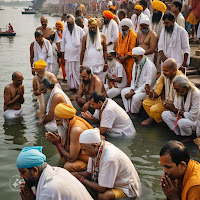Discover the Sacred Significance of Kumbh Mela: A Large social spiritual Gathering
KUMBH MELA
Introduction
The Kumbh Mela, or "festival of the sacred pitcher," is a religious celebration held every three years in India at one of four locations: Prayag, Haridwar, Nasik, and Ujjain. Except for the Sangam, which is located at the confluence of the Ganga, Yamuna, and Saraswathi rivers and is regarded the holiest of the four places, the celebration rotates between the cities. The Kumbh Mela is not just a religious gathering; it is a cultural phenomenon, steeped in tradition, spirituality, and history.The Origins of Kumbh Mela
The Kumbh Mela, or Kumbh, is a Hindu celebration with several roots. The Kumbh Mela originated in ancient Hindu mythology. According to tradition, the gods (Devas) and devils (Asuras) churned the ocean (Samudra Manthan), revealing a pot (Kumbh) carrying the nectar of immortality. During the subsequent struggle for the Kumbh, drips of this nectar fell in four locations: Prayagraj, Haridwar, Nashik, and Ujjain. These cities became the sites of the Kumbh Mela, in which it is thought that taking a bath in the sacred waters during the festival will wash away one's sins and bring salvation.
The UNESCO recognised the Kumbh Mela as an "Intangible Cultural Heritage of Humanity" in 2017, further cementing its status as a cultural treasure. The Kumbh Mela’s global appeal lies in its ability to offer a transformative experience, where people can connect with the divine, explore ancient traditions, and witness the power of collective faith.
The Future of Kumbh Mela
The next Kumbh Mela, a major religious gathering in India, is slated to take place in Allahabad (Prayagraj) from January 13 and February 26, 2025.The Kumbh Mela, a symbol of India's rich legacy, faces the difficulty of maintaining its ancient identity while adapting to its modern culture. Its future depends on its ability to preserve spiritual and cultural relevance while accepting modernity and conservation.
Role of Sadhus in Kumbh mela
Sadhus, Hindu holy men and ascetics, renounce worldly life for spiritual liberation, participate in the Kumbh Mela, a significant religious gathering, performing rituals and seeking blessings. Kumbh Mela involves Sadhus from various sects and orders, including Naga Sadhus and Aghoris, participating in rituals and ceremonies, including Shahi Snan, a holy dip believed to cleanse sins and aid in moksha attainment. For many pilgrims attending the Kumbh Mela, the opportunity to see and interact with Sadhus is a significant draw. These holy men are revered for their spiritual knowledge, austerity, and mystical powers. Pilgrims seek their blessings, spiritual guidance, and participate in discourses or rituals led by them. In summary, Sadhus and the Kumbh Mela are intricately connected through shared spiritual practices, religious significance, and cultural traditions, making the festival a profound experience for both the ascetics and the millions of devotees who attend.
Conclusion
As the vibrant colours of the Kumbh Mela fade into memories, the spiritual essence of this grand festival lingers on, inspiring millions around the world. Whether you're drawn to its cultural richness, spiritual significance, or the sheer scale of human connection, the Kumbh Mela is an experience like no other. So, when the next Kumbh Mela calls, be sure to immerse yourself in this timeless tradition—where every dip in the holy waters brings not just purification, but a deeper connection to the divine. Plan your journey, embrace the experience, and let the magic of Kumbh Mela become a part of your story.






Comments
Post a Comment